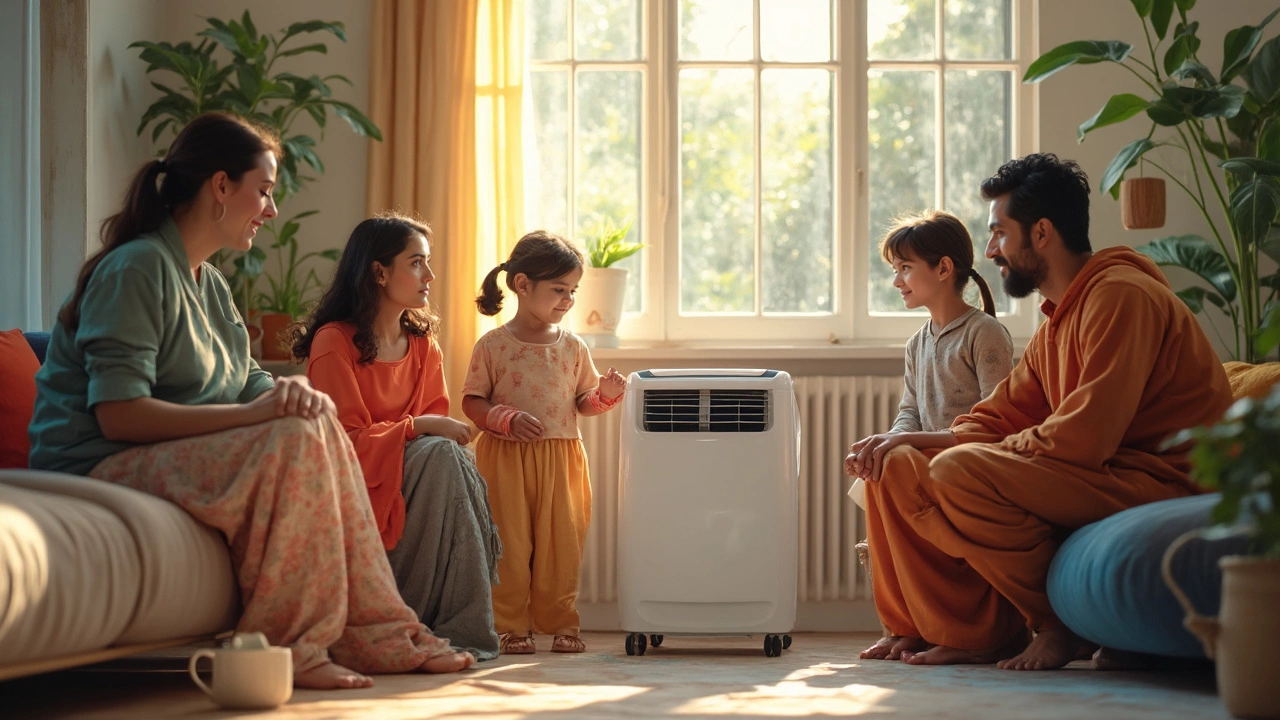
So you're trying to cool down your space, and you're stuck between choosing a window air conditioner and a portable one. It's not as straightforward as you'd think! Each type has its own quirks and perks. Let's break it down to make your decision easier.
When it comes to cooling power, window units often pack a bigger punch. They usually have higher BTUs (British Thermal Units), meaning they can cool larger areas. But the hitch? You're gonna need a compatible window and maybe even some muscles for installation.
Now, portable units might not have the same raw power, but they win big on flexibility. You can move them from room to room, and you don't have to deal with heavy lifting or permanent fixtures. Want to cool your bedroom at night and your living room by day? A portable AC can do that. Plus, they're great if you're a renter and can't mess with the place too much.
- Understanding Cooling Capacity
- Installation and Flexibility
- Energy Efficiency and Cost
- Noise and Maintenance
Understanding Cooling Capacity
Alright, let's dive into the nitty-gritty of how much cooling power you actually need. In the world of air conditioning, BTUs are king. This little term stands for British Thermal Units, a measure of how much heat an air conditioner can remove from a space per hour. Bigger spaces mean more BTUs—you don't want your AC working overtime just to keep you comfortable.
For instance, a small room, say 150 to 250 square feet, will typically need a unit with around 5,000 to 6,000 BTUs. On the other hand, if you've got a larger space, like a 550 to 700 square foot living room, you're going to be looking at something like 12,000 to 14,000 BTUs. Pretty straightforward, right?
Now, when comparing window air conditioners and portable air conditioners, the former often offers more bang for your buck regarding BTUs. They're usually more effective for cooling because they're designed to stay put and vent directly outside, meaning they handle heat removal more efficiently.
Portable ACs, meanwhile, can still pack quite a punch, but you might need a slightly higher BTU rating to cover the same-sized room as a window unit. Plus, portable units tend to recycle some indoor air to create a cooling effect, which might not be as efficient if you're trying to cool larger spaces.
- Window Unit Advantages: Higher BTU efficiency, better for stationary cooling, direct venting.
- Portable Unit Advantages: Flexibility in placement, ease of movement, no permanent installation required.
Here's a quick comparison:
| Room Size (sq ft) | Recommended BTU (Window AC) | Recommended BTU (Portable AC) |
|---|---|---|
| 150-250 | 5,000-6,000 | 6,000-7,500 |
| 350-450 | 8,000-10,000 | 9,000-12,000 |
| 550-700 | 12,000-14,000 | 13,000-16,000 |
Keep these numbers in mind when you're shopping, and you'll be on your way to a more comfortable home environment. Make this choice wisely, and your perfect chill-spot isn’t far off.
Installation and Flexibility
Alright, so when it comes to setting up a window air conditioner, you'll need a bit of elbow grease. First, you'll need a window that opens vertically. This usually means a double-hung window is your best friend. Once you've found your spot, installing the unit requires proper mounting and sometimes dealing with a tiny house construction project to seal any gaps. This ensures no hot air sneaks in, ruining your cool vibes.
Here's a quick list of steps involved in installing a window unit:
- Ensure the window can support the weight of the AC unit.
- Securely place the unit in the window, ensuring it sits level.
- Use mounting brackets if provided, for extra support.
- Seal around the unit with foam or weather strips to prevent air leaks.
On the flip side, portable air conditioners shine when it comes to ease and adaptability. You don't have to be a DIY master. Just roll the unit to where you need it, hook it up to a power source, and attach the exhaust hose to the nearest window using a simple kit. It usually involves placing a small adapter in the window, similar to a cat flap.
The flexibility of portable units cannot be overstated. If your home has limited window access or if you're not keen on blocking your scenic view, these bad boys are a game-changer. Plus, they're perfect if you like to rearrange your living space regularly or want to switch rooms for a change of vibe.
Check out this comparison of typical installation times:
| Air Conditioner Type | Average Installation Time |
|---|---|
| Window AC | 1-2 hours |
| Portable AC | 15-30 minutes |
So, while window units are more of a 'set and forget' deal, portable ones offer the kind of versatility that's hard to beat, especially if commitment's not your thing.

Energy Efficiency and Cost
When it comes to energy efficiency, both window and portable air conditioners have their own stories. Most window units tend to be more energy-efficient. You'll notice they've got higher EER (Energy Efficiency Ratio) ratings compared to portable units. This means they use less electricity to cool the same amount of space, which can lead to lower electricity bills over time.
Portable air conditioners, on the other hand, might cost a bit more to run. They usually have lower EER ratings, which means they use more power. Sure, they offer flexibility, but that sometimes comes with a higher operating cost. If you're cooling a space frequently, those costs can add up.
Beyond just the energy factor, there's the initial price and ongoing spending. Typically, window units are less expensive upfront. You’ll find that portable air conditioners generally come with a higher price tag, partly due to their convenience factor. And don’t forget about maintenance costs. Portables might need more regular upkeep, like emptying water tanks or cleaning filters more often.
| Type | Average EER | Monthly Cost* |
|---|---|---|
| Window AC | 10-12 | $30-$50 |
| Portable AC | 8-10 | $40-$70 |
*Monthly costs can vary based on usage and rates, but this gives you a ballpark figure for what to expect.
Before dropping cash on either, think about the long-term. If you're going for energy savings, a window unit may be the better bet. But if you value flexibility and can handle a slightly higher power bill, a portable unit is worth considering. After all, how often does convenience come cheap?
Noise and Maintenance
When it comes to the noise levels of air conditioners, it can be a bit of a dealbreaker for some folks. If you're sensitive to sound, here's what you gotta know.
Window air conditioners generally make a bit more noise than their portable counterparts. Their compressors and fans are positioned right up against your window, and while they're busy cooling your space, they can also be buzzing away. Think of it like having a constant white noise machine, which could either lull you to sleep or drive you up the wall.
On the flip side, portable air conditioners tend to whisper rather than shout. They're typically quieter because they have parts that sit inside the room rather than hanging out of the window, and their sound is more of a dull hum rather than a racket. Great if you need peace while you're working or chilling.
Now let's talk about keeping these coolers in tip-top shape.
- Window air conditioners require routine cleaning of filters, and you'll need to check for any blockages in the vents. Taking them down for a thorough clean can be cumbersome, especially if you've mounted it securely.
- Portable air conditioners are a bit easier on this front. Simply slide out the filter, rinse, let it dry, and pop it back. Also, these usually have water tanks that collect condensed water, so remember to empty them regularly to prevent leaks. Some models might come with a nifty auto-evaporation feature, which is a nice touch.
If you're all about convenience and can't handle the idea of dismantling an AC for cleaning, the portable route might be more your speed.